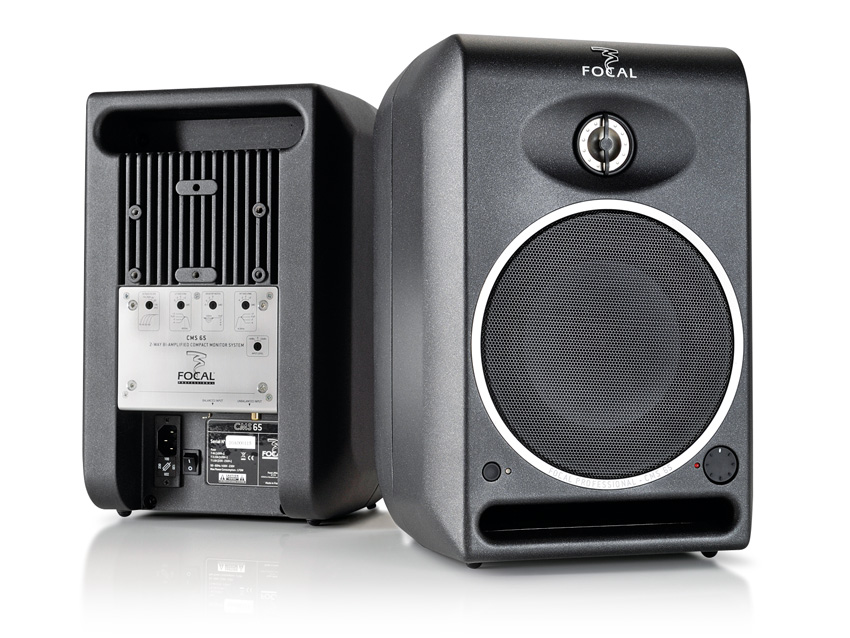MusicRadar Verdict
The CMS65 throws down the gauntlet - natural, detailed, compact and a pleasure to use
Pros
- +
Natural detailed sound. Excellent build quality. Compact.
Cons
- -
Expensive.
MusicRadar's got your back
The CMS65 is the larger of two new monitor options from Focal (the CMS50 is the other). Both have a traditional two-way design and are aimed at smaller control rooms, post production and the home studio market.
At more than £1,200 a pair they're up against the likes of Genelec, PMC and Adam to name but a few - competition is very tough at this price point.
In detail
The CMS65 has a bi-amplified front-ported design with a 6.5-inch woofer and Focal's inverted dome tweeter. The woofer uses a Polyglass cone (that's glass microballs on cellulose pulp to you and me) and an Aluminium/ Magnesium tweeter.
Both technologies are slightly different to Focal's SM6 line, as is the cabinet material, which in this case is die cast aluminium rather than MDF. Power comes from 100W LF and 60W HF amplifiers both operating in AB mode, producing a maximum SPL of 112dB at 1m.
Overall frequency response is +/- 3dB across a 45Hz to 28kHz range, demonstrating good low frequency extension.
To accommodate varying room characteristics, round the back you'll find four notched EQ trim pots - HF and LF shelving EQs, a high-pass filter and a desktop notch EQ. The shelving EQs are at 450Hz and 4.5kHz (-4, -2, 0 and +2dB) and the high pass is 12dB/octave (45, 60 and 90Hz).
The notch is designed to reduce desktop reflections around the 160Hz mark - settings are 0, -2, -4 and -6dB.
To get connected you'll need either XLR or phono cabling (but not 1/4-inch jack), and levels are set using the front panel volume control. Finally, there's a mains switch round the back and a 'soft' power switch on the front.
Each CMS65 comes equipped with four push-in rubber feet, two screw-in adjustable feet and one rubber mat. Using a combination of four feet, you can angle the monitors in the vertical plane. In use, with all four feet bedded into the rubber mat dimples, we thought the monitors felt very stable indeed.
The two protective metal driver grilles can be removed and, in the case of the tweeter, replaced with a plastic 'phase plug'. In practice, we found both changes improved the sound, and we'd be reluctant to use the protection grilles at all.
Sound and summary
Sonically, the CMS65 is a great performer. Often, metal-domed tweeters can sound a little harsh and a tad abrasive, but we really didn't feel this here. In fact, there's nothing particularly 'hyped' about the sound at either frequency extreme.
Although we didn't feel the need, we did run through all the EQ and tweaking options and they do serve a purpose if you absolutely need them for your particular room. The notch setting would be particularly helpful if you had the CMS65 close to a large mixing desk.
Even so, we feel that the frequency balance and imaging has been 'tuned' so well it would be a shame to modify it unnecessarily.
For a compact monitor, the CMS65 produces a big, wide, detailed and uncoloured sound that easily competes with the other big hitters in this price class and is a pleasure to mix on. Yes they're quite pricey, but they're worth every penny.
Future Music is the number one magazine for today's producers. Packed with technique and technology we'll help you make great new music. All-access artist interviews, in-depth gear reviews, essential production tutorials and much more. Every marvellous monthly edition features reliable reviews of the latest and greatest hardware and software technology and techniques, unparalleled advice, in-depth interviews, sensational free samples and so much more to improve the experience and outcome of your music-making.
“I called out to Mutt and said, ‘How about this?’... It was a complete fluke": How Def Leppard created a rock anthem - with a little bit of divine intervention
Baby Audio's Smooth Operator spectral balancing plugin goes pro
"It was ugly, like watching a divorce between four people. After a while, I had to get out": Beatles engineer Geoff Emerick on the recording of Abbey Road, track-by-track











